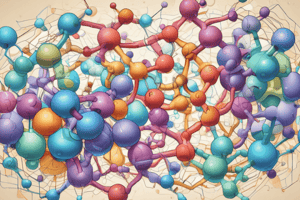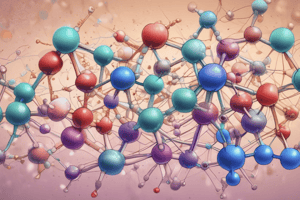Podcast
Questions and Answers
Which type of interaction is stronger than H-bonds and can extend over greater distances?
Which type of interaction is stronger than H-bonds and can extend over greater distances?
- Dipole-dipole interactions
- Hydrophobic interactions
- Van der Waals forces
- Charge-charge interactions (correct)
What is the main reason for the poor solubility of substances with hydrophobic interactions?
What is the main reason for the poor solubility of substances with hydrophobic interactions?
- Formation of strong hydrogen bonds with water
- Absence of polar bonds that can interact with water molecules (correct)
- Increase in entropy upon dissolution
- Interaction with other nonpolar groups in solution
What type of molecules contain both polar and nonpolar regions, exhibiting distinct properties?
What type of molecules contain both polar and nonpolar regions, exhibiting distinct properties?
- Hydrophilic molecules
- Amphipathic molecules (correct)
- Amphoteric molecules
- Hydrogen bond forming molecules
In the context of water dissociation, what does a low pH value indicate?
In the context of water dissociation, what does a low pH value indicate?
Which concept describes water as a proton donor and has a conjugate base when deprotonated?
Which concept describes water as a proton donor and has a conjugate base when deprotonated?
What does the Henderson-Hasselbalch equation help determine in weak acid solutions?
What does the Henderson-Hasselbalch equation help determine in weak acid solutions?
Which factor contributes to the distinct cis and trans conformations of peptide groups?
Which factor contributes to the distinct cis and trans conformations of peptide groups?
Why is the cis conformation of peptide groups less favorable than the trans conformation?
Why is the cis conformation of peptide groups less favorable than the trans conformation?
What restricts the rotation of the N-Calpha bond in proline?
What restricts the rotation of the N-Calpha bond in proline?
What type of trajectory do alpha atoms follow in an alpha helix?
What type of trajectory do alpha atoms follow in an alpha helix?
What stabilizes an alpha helix through many nearly parallel interactions?
What stabilizes an alpha helix through many nearly parallel interactions?
What defines the pitch of an alpha helix in terms of its geometry?
What defines the pitch of an alpha helix in terms of its geometry?
What is the main role of Na+-K+ ATPase in active transport?
What is the main role of Na+-K+ ATPase in active transport?
How does the flow of Na back down its concentration gradient contribute to active transport?
How does the flow of Na back down its concentration gradient contribute to active transport?
What is the function of nitrogenase in the production of ammonia?
What is the function of nitrogenase in the production of ammonia?
How do enzymes facilitate reactions?
How do enzymes facilitate reactions?
In terms of structure, what can enzymes consist of?
In terms of structure, what can enzymes consist of?
What effect do catalysts, such as enzymes, have on reactions?
What effect do catalysts, such as enzymes, have on reactions?
What does the kcat/Km value indicate about an enzyme reaction?
What does the kcat/Km value indicate about an enzyme reaction?
In the Lineweaver-Burk plot, what does the slope represent?
In the Lineweaver-Burk plot, what does the slope represent?
What type of reactions do lyases catalyze?
What type of reactions do lyases catalyze?
Which class of enzymes catalyzes oxidation-reduction reactions?
Which class of enzymes catalyzes oxidation-reduction reactions?
What is the largest class of enzymes based on their abundance?
What is the largest class of enzymes based on their abundance?
Which enzyme classification includes enzymes that catalyze group transfer reactions?
Which enzyme classification includes enzymes that catalyze group transfer reactions?
At what pH does an amino acid exist in a zwitterion form?
At what pH does an amino acid exist in a zwitterion form?
What is the distinguishing feature of proline among amino acids?
What is the distinguishing feature of proline among amino acids?
Which amino acid forms disulfide bonds to stabilize extracellular proteins?
Which amino acid forms disulfide bonds to stabilize extracellular proteins?
What is the pH range at which acidic amino acids like aspartic acid (D) and glutamic acid (E) exhibit strong H-bonding abilities?
What is the pH range at which acidic amino acids like aspartic acid (D) and glutamic acid (E) exhibit strong H-bonding abilities?
Which amino acid can coordinate with metal ions and exhibit hydrogen bonding?
Which amino acid can coordinate with metal ions and exhibit hydrogen bonding?
Which characteristic differentiates basic amino acids from other types of amino acids?
Which characteristic differentiates basic amino acids from other types of amino acids?
What is the primary function of proteins according to the text?
What is the primary function of proteins according to the text?
In what form does the polypeptide chain of a protein fold under physiological conditions?
In what form does the polypeptide chain of a protein fold under physiological conditions?
"Peptide bonds eliminate the ionizable alpha-carboxyl groups of free amino acids." This statement emphasizes what aspect of peptide bond formation?
"Peptide bonds eliminate the ionizable alpha-carboxyl groups of free amino acids." This statement emphasizes what aspect of peptide bond formation?
Flashcards are hidden until you start studying
Study Notes
Non-Covalent Interactions
- Hydrogen bonds (H-bonds) are strong if all three atoms are aligned
- H-bonds are classified into two main types: hydrogen donors (imino and hydroxyl groups) and hydrogen acceptors (three types)
- Charge-charge interactions: electrostatic interactions between opposite charges, stronger than H-bonds, and can extend over greater distances
- Van der Waals forces: weak interactions between permanent or induced dipoles, only work at short optimal distances, but a large number of interactions add up to a significant stabilizing force
- Hydrophobic interactions: few or no polar bonds, cannot engage in hydrogen bonds with water molecules, poorly soluble, and increase in entropy
Water and Solubility
- Water is a dipole, allowing it to form hydrogen bonds with itself
- The stronger the polarity, the more soluble
- Polar water molecules align themselves around polar molecules, making solvation energetically favorable
- Solvation is favored over the crystal lattice, and ions dissolve
- The organization of the hydration shell is energetically favorable
Dissociation of Water and Acids
- Water dissociation: pH = -log10(H+), pH + pOH = 14
- The Brønsted acid concept: water as a proton donor and acceptor
- Dissociation of strong and weak acids
- pH of weak acid solutions: Henderson-Hasselbalch equation
- Buffer function: ability to resist changes in pH when acid or base is added
Amino Acids
- Central dogma of molecular biology: DNA → RNA → protein
- Proteins are built from 20 building blocks (amino acids)
- Protein functions: enzymatic reactions, transport, carrier proteins, channels, structural proteins, motor, gene expression, signaling, defense, and attachment
- Amino acid structure: amino group, carboxyl group, R group, and alpha carbon atom
- Amino acids carry both negative and positive charges, forming a zwitterion
- Alpha carbon is chiral/asymmetric, and stereochemistry of amino acids is important
- Individual properties of amino acids: aliphatic, aromatic, sulfur-containing, basic, acidic, amides, and alcohols
Primary and Secondary Structure
- Primary structure: the linear sequence of amino acids, unique sequence for a protein
- Peptide bonds link amino acids in proteins, forming a peptide chain
- Formation of peptide bonds eliminates the ionizable alpha-carboxyl groups of free amino acids
- Polypeptide chain nomenclature: each amino acid subunit of a protein is one residue
- Four levels of protein structure: primary, secondary, tertiary, and quaternary
Conformational Properties of the Polypeptide Chain
- Factors contributing to protein structure: allowable bond rotations, weak non-covalent interactions between backbone and sidechain groups
- Peptide group: atoms lie in one plane, and the C-N peptide bond has double bond character
- Trans and cis conformations of a peptide group: trans is more favorable due to steric interference
- Rotation of bonds in a peptide chain: restricted by steric interference between main chain and side chain atoms
- The Ramachandran plot: a 2D representation of the phi and psi angles, showing the allowed regions of the plot
Secondary Structure - Alpha Helices
- Secondary structure: regularly repeating conformations of the polypeptide backbone
- Alpha helix: a right-handed helix, stabilized by many hydrogen bonds, with a dipole moment
- Pitch of the helix: the advance along the helix long axis per turn
Studying That Suits You
Use AI to generate personalized quizzes and flashcards to suit your learning preferences.




